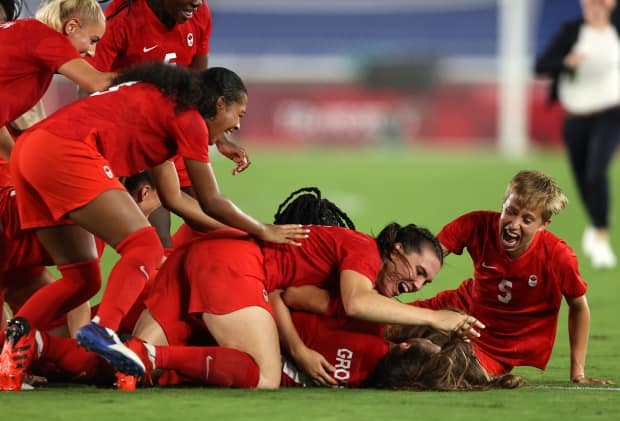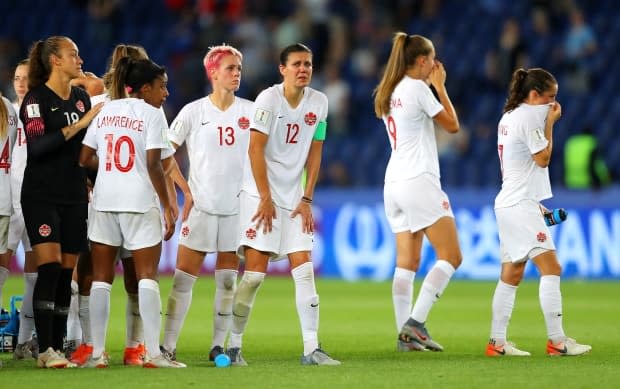Why Canadian women's soccer thrives at Olympics but can't shake World Cup struggles

The Canadian women's soccer team captured the imagination of the entire country at the Tokyo Olympics, finally striking gold after winning back-to-back bronze medals at London 2012 and Rio 2016.
But even though the box next to "change the colour of the medal" has been ticked, Canadian coach Bev Priestman has her eyes on the biggest prize in women's soccer — specifically, winning the 2023 FIFA World Cup that will be co-hosted by Australia and New Zealand.
"What I definitely want to ensure is that this gold medal wasn't just a one-off, that we just didn't do it once and then rode away into the sunset and were happy with that. For me, it'll be about us getting into that arena more often. Fresh on my mind at the moment is the World Cup," Priestman recently told reporters.
But considering Canada's track record, capitalizing on its Olympic gold medal at the next World Cup will be easier said than done.
Women's soccer made its Olympic debut in 1996 in Atlanta, and Canada first qualified at Beijing 2008 when it bowed out in the quarter-finals. Since then, the Reds have reached the podium on three consecutive occasions.
Success at the Women's World Cup has been much harder to come by. Canada has competed in seven tournaments since making its debut in 1995, and has been eliminated in the group stage four times — including in 2011 when it finished in last place. Canada reached the semifinals in 2003, but it was never able to build upon that in its two other appearances in the knockout round.
WATCH | Canadian women capture an Olympic gold medal:
Why the disparity in results?
So why the disparity in results and performances for Canada in the two biggest and most prestigious competitions in women's soccer?
For starters, the tournaments are completely different beasts — the 2023 World Cup will feature 32 teams (up from 24 in 2019 in France), compared to the Tokyo Olympics where 12 nations competed. While the Olympics have shorter turnarounds between matches and smaller rosters, the World Cup features more travel, and a greater diversity and strength of teams.
Germany and France are two of the top nations in the women's game — they were second and third in the FIFA world rankings prior to the Tokyo Olympics — while 12th-ranked Spain has grown by leaps and bounds since its World Cup debut in 2015. But all three nations didn't qualify for Tokyo, falling victim to a number's game as Europe is only given three tournament spots.
Former Canadian midfielder Amy Walsh, who played at the 1999 and 2007 World Cups and the 2008 Olympics, argues that this makes the World Cup a more difficult tournament to win.
"The field of 12 teams in Tokyo was missing Germany and France, so with the smaller field, you are reducing the competition and the level of play, to a certain extent," Walsh told CBC Sports.
Walsh also argues there is far less margin of error at the World Cup than the Olympics, which is more forgiving when you consider eight of the 12 teams qualify for the knockout round.
"From your first game at the World Cup, you have to get points no matter who your opponent is so you can build that momentum and you're not under the gun going into your final group stage game and needing a result against a higher seed," said Walsh, who scored five goals in 102 appearances for Canada from 1997 to 2009.

Avoiding another post-Olympic letdown
Another issue that Priestman will have to be wary of is the Canadian team suffering another post-Olympic letdown. After winning bronze at London 2012, Canada disappointingly bowed out in the quarter-finals of the 2015 World Cup on home soil. Another bronze in Rio 2016 was followed up by a meagre round of 16 exit at the World Cup three years later in France.
Canada's only significant run at the World Cup came in 2003 when it finished fourth, but the tournament only featured 16 teams and international women's soccer has changed a lot since then.
The World Cup expanded to 24 teams in 2015 and will add an additional eight countries in 2023, while at the same time nations have dedicated more money and resources into their women's programs over the years.
"The expansion of the women's game, the money that's been put into it… programs that were previously fledgling or not getting the support it needed, money is now getting poured into them. All these nations are closing the gap," offered Walsh, who was inducted into the Canada Soccer Hall of Fame in 2017.
"Just when Canada has looked poised to make that leap and get results at the World Cup, the field expands, so now they're seeing teams they haven't played before, there's a little more of an unknown in opponents, and they've been unable to capitalize on their Olympic momentum."
It's a fact not lost on Priestman.
"Is it the high of an Olympics, and we can't get ourselves up again for that World Cup? Where does the hunger come from in doing well in an Olympics? And [how do we] translate that into a World Cup? These are all the deep questions that I've got to ask myself and throw around to put that plan together to make sure that in 2023 this team is ready and can deliver on their ability," Priestman said.

 Yahoo Sports
Yahoo Sports 